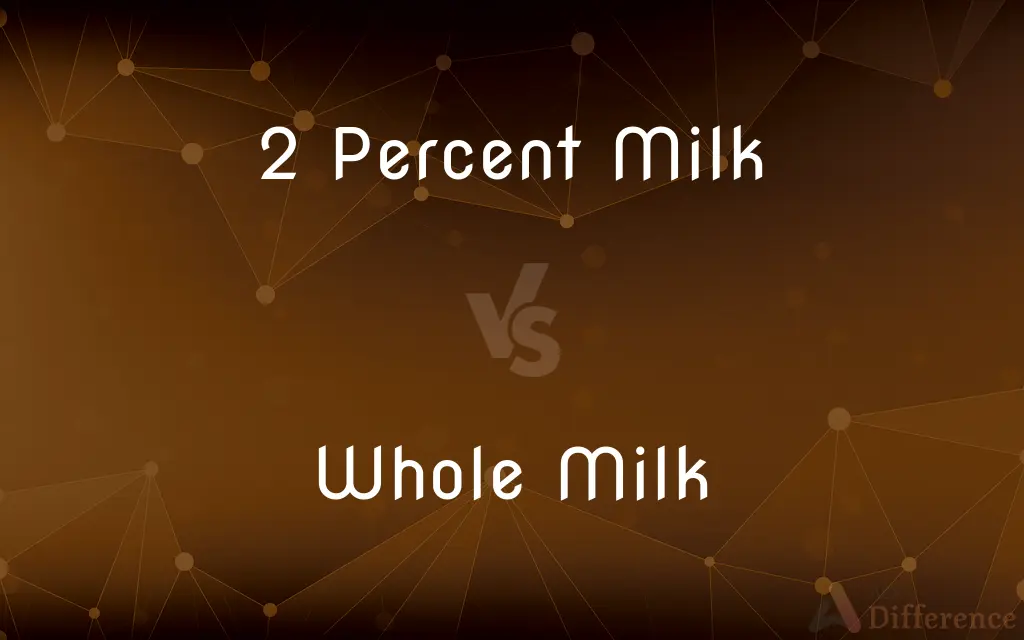2 Percent Milk vs. Whole Milk — What's the Difference?
By Tayyaba Rehman & Maham Liaqat — Published on March 6, 2024
2% milk, also known as reduced-fat milk, contains 2% milk fat, offering a balance between flavor and reduced calorie content. Whole milk contains about 3.25% milk fat, providing a richer taste and creamier texture but with higher calories and fat.

Difference Between 2 Percent Milk and Whole Milk
Table of Contents
ADVERTISEMENT
Key Differences
2% Milk and Whole Milk differ primarily in their fat content, which significantly influences their nutritional profile, taste, and texture. Whole milk, with its approximately 3.25% milk fat, is valued for its creamy texture and rich flavor, making it a preferred choice for those not concerned about fat intake. It is high in vitamins and minerals, especially fat-soluble vitamins like A and D, which are naturally present in the milk fat.
2% Milk, on the other hand, strikes a middle ground by reducing the fat content to 2%, thereby lowering the calories without sacrificing too much of the taste and nutritional value found in whole milk. The reduction in fat makes 2% milk a popular choice for individuals seeking a balance between health concerns and flavor preferences. It still contains a good amount of proteins, vitamins, and minerals, although some fat-soluble vitamins are reduced with the removal of fat.
The choice between 2% milk and whole milk often comes down to dietary preferences, health goals, and taste. Whole milk is sometimes recommended for children up to 2 years old due to the need for dietary fats in brain development, while adults often opt for 2% milk to manage calorie intake or dietary fat. Both types undergo the same processing steps, including pasteurization and homogenization, ensuring safety and a uniform texture.
In terms of culinary uses, whole milk adds richness and depth to recipes, such as baked goods and sauces, while 2% milk is often used as a lighter alternative that still provides moisture and flavor without the added fat. Both can be consumed directly, used in cereal, or incorporated into coffee and tea, with the choice affecting the beverage's creaminess and overall calorie content.
Comparison Chart
Milk Fat Content
2%
Approximately 3.25%
ADVERTISEMENT
Calories
Lower than whole milk
Higher due to more fat
Taste
Less rich, but still creamy
Richer and creamier
Texture
Slightly less creamy than whole milk
Creamiest option
Nutritional Value
Reduced fat, but retains most vitamins
Higher in fat-soluble vitamins
Recommended For
Calorie-conscious consumers
Children and those not limiting fat intake
Culinary Uses
Lighter baked goods, beverages
Richer flavor in recipes, creamy beverages
Compare with Definitions
2 Percent Milk
Popular in dietary plans focusing on reduced fat.
My nutritionist recommended 2% milk for my weight loss diet.
Whole Milk
Ideal for culinary uses that require richness.
I use whole milk in béchamel sauce for extra creaminess.
2 Percent Milk
Versatile in cooking, providing moisture without heaviness.
I use 2% milk in pancakes for a lighter texture.
Whole Milk
Chosen for its natural composition without fat removal.
I prefer whole milk for its unaltered, natural taste.
2 Percent Milk
It offers a balance between full flavor and lower calories.
2% milk enriches my morning coffee without too much fat.
Whole Milk
Whole Milk is valued for its creamy texture and rich flavor.
Whole milk makes my homemade ice cream deliciously creamy.
2 Percent Milk
Suitable for those managing cholesterol or heart health.
After my doctor's advice, I started using 2% milk.
Whole Milk
Contains all the natural fat of milk, offering nutritional benefits.
Whole milk provides essential fats for my toddler's growth.
2 Percent Milk
2% Milk contains reduced fat for a healthier option.
I switched to 2% milk to lower my daily fat intake.
Whole Milk
Preferred for its contribution to bone health.
The vitamin D in whole milk helps with calcium absorption.
Common Curiosities
Is 2% milk significantly lower in calories than whole milk?
Yes, 2% milk has fewer calories due to its reduced fat content, making it a preferred option for calorie-conscious individuals.
Can switching from whole milk to 2% milk help with weight loss?
While switching to 2% milk can reduce calorie and fat intake, balanced diet and exercise are also crucial for weight loss.
Can I use 2% milk instead of whole milk in recipes?
Yes, 2% milk can be used as a lighter alternative in most recipes, though the final product may be less rich.
How are the fat-soluble vitamins affected by the fat reduction in 2% milk?
The reduction in fat means that 2% milk has slightly lower levels of fat-soluble vitamins than whole milk, though it's still a good source of these nutrients.
Is organic 2% milk different from regular 2% milk?
Organic 2% milk comes from cows fed organic feed and without antibiotics or hormones, but the fat content and nutritional profile are similar to regular 2% milk.
Why might whole milk be recommended for young children?
The dietary fats in whole milk are important for brain development in children up to 2 years old.
Does 2% milk provide the same calcium as whole milk?
Yes, both 2% and whole milk offer similar calcium levels, important for bone health.
Are there any health risks associated with consuming whole milk?
For individuals with certain health conditions like high cholesterol, limiting saturated fat intake, including from whole milk, may be advised.
Is there a taste difference between 2% and whole milk?
Yes, whole milk has a richer, creamier taste due to its higher fat content, while 2% milk is slightly less rich.
Can lactose-intolerant individuals consume 2% or whole milk?
Both 2% and whole milk contain lactose and may not be suitable for those with lactose intolerance, unless they're lactose-free versions.
Share Your Discovery

Previous Comparison
Compression Wood vs. Tension Wood
Next Comparison
Chrome vs. SafariAuthor Spotlight
Written by
Tayyaba RehmanTayyaba Rehman is a distinguished writer, currently serving as a primary contributor to askdifference.com. As a researcher in semantics and etymology, Tayyaba's passion for the complexity of languages and their distinctions has found a perfect home on the platform. Tayyaba delves into the intricacies of language, distinguishing between commonly confused words and phrases, thereby providing clarity for readers worldwide.
Co-written by
Maham Liaqat















































